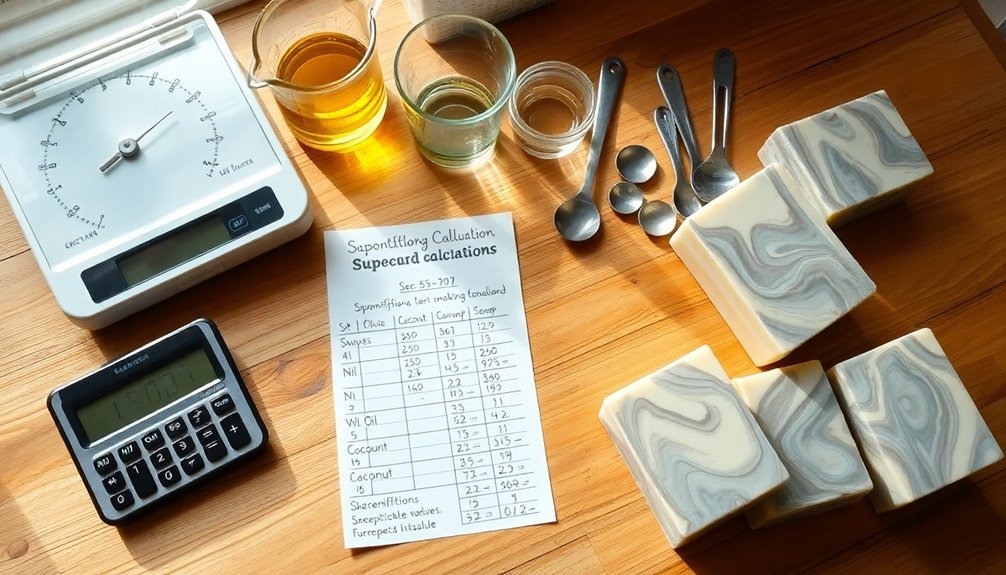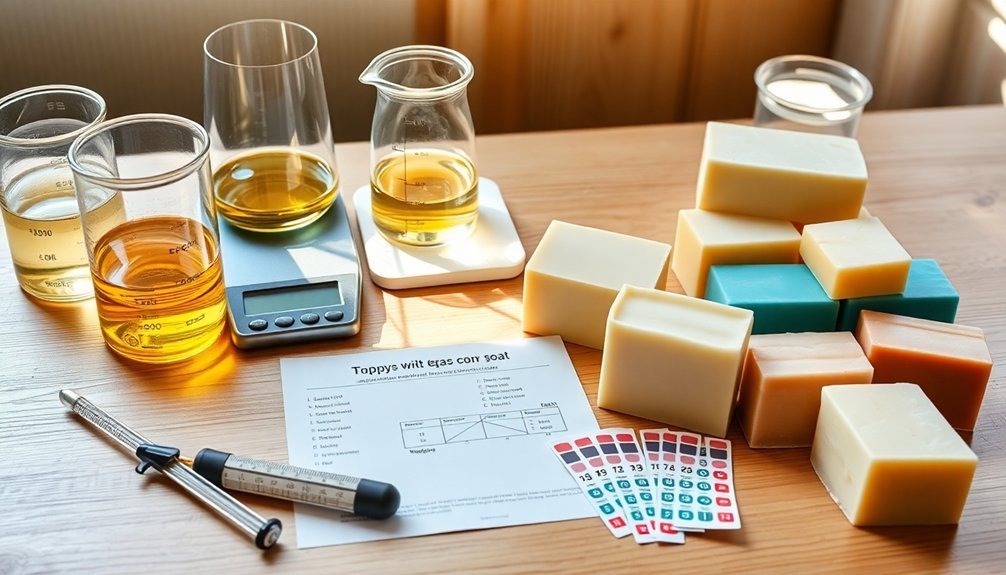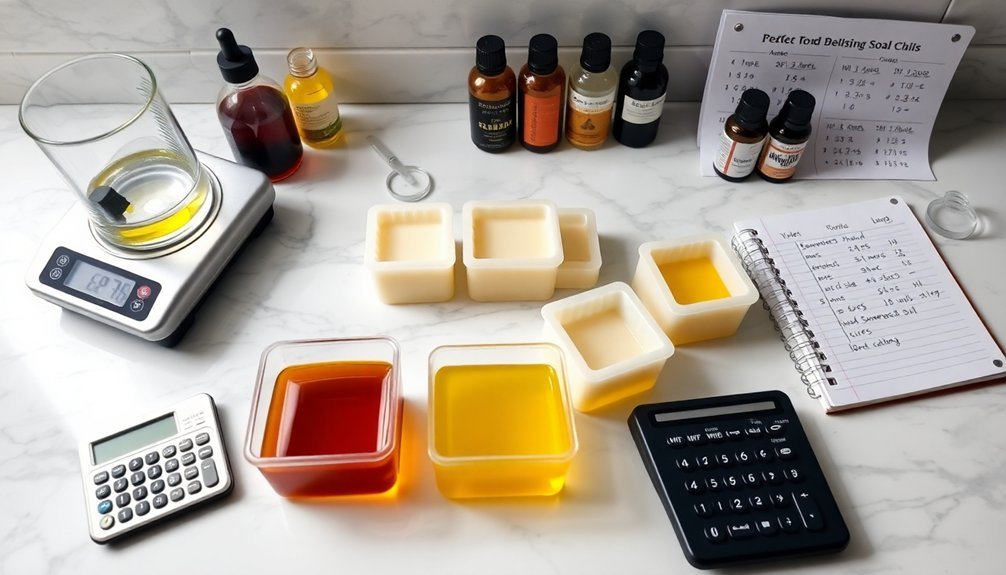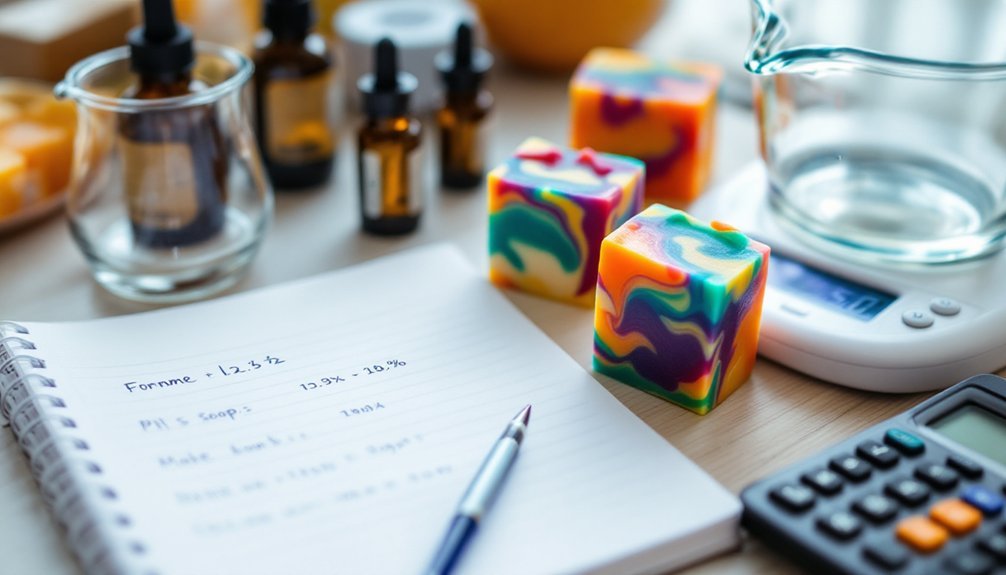When making soap, you'll need to master oil blend math. Always guarantee your oils total 100% for accurate lye calculations. Use weight measurements instead of volume for precision. Calculate superfat percentage (typically 5%) to enhance moisturizing properties. Measure essential oils carefully, starting with 2-3% of total batch weight. Scale recipes using percentages rather than fixed amounts. Try the "parts" method for simpler formulations. Use a digital scale for consistent results. These fundamentals will transform your soap-making journey.
7 Smart Tips For Soap Oil Blend Math

While soap making might seem like an art, the foundation rests firmly in mathematics. When crafting your oil blends, always guarantee they total exactly 100% to maintain proper recipe balance.
You'll need a lye calculator to determine the correct amount of lye based on your oils' saponification values. Converting percentages to weights is straightforward—if you're using 30% coconut oil in a 50 oz. batch, you'll need 15 oz. of that oil.
Consider the properties each oil brings to your soap. Hard oils like coconut create firmness, while liquid oils like olive contribute softness.
When adjusting your recipe, monitor your superfat percentage carefully—typically between 5-20%—to achieve your desired moisturizing effect.
Understanding the 100% Rule for Oil Proportions
You'll need to guarantee all oil percentages in your soap recipe add up to exactly a clean 100%, as this precise measurement directly affects your lye calculations and final product quality.
This balance isn't just mathematical—each oil contributes specific properties to your bar, with coconut creating lather, olive adding moisture, and castor boosting bubble stability.
When you adjust one oil's proportion, you must correspondingly modify others to maintain both the mathematical balance and your desired soap characteristics.
Measuring Matters
Every successful soap recipe follows the fundamental 100% rule—a non-negotiable principle that guarantees your formulation remains balanced. When crafting your blend, verify all oil amounts collectively equal 100%, no more and no less.
For instance, if you're working with three oils, you might allocate 40% to coconut oil, 30% to olive oil, and 30% to shea butter.
Need to adjust one percentage? You'll need corresponding changes to the others. If you're increasing coconut oil to 45%, reduce the remaining oils proportionally.
When substituting ingredients in your soap recipe, recalculate your percentages carefully.
Balancing Bar Properties
Creating the perfect soap bar requires understanding how different oils contribute unique properties to your final product. When balancing your oil blend, remember the 100% rule—all oils in your recipe must collectively equal exactly 100%. This guarantees your soap achieves the right balance of hardness, lather, and moisturizing qualities.
- Start with ratios – If you're using 30% coconut oil for cleansing, 30% palm oil for hardness, and 30% olive oil for moisturizing, you'll have 10% remaining for specialty oils.
- Adjust proportions – When adding shea butter or castor oil, reduce your base oils accordingly to maintain the 100% total.
- Verify calculations – Always run your final recipe through a lye calculator to confirm your oil percentage math translates to the correct lye amount for safe soapmaking.
Converting Between Weight and Volume Measurements

When converting oils from weight to volume in your soap recipes, you'll need to account for each oil's specific density, as palm oil (0.89 g/ml) differs markedly from olive or coconut oil.
You can use conversion tables to quickly translate between grams and milliliters, remembering that the standard 1 oz = 29.57 ml needs adjustment based on your oil's density factor.
For consistent results, invest in a digital scale to weigh your oils directly rather than measuring by volume, especially when working with precise formulations.
Density Calculation Fundamentals
Although many soap makers initially struggle with conversion measurements, understanding density fundamentals will transform how you approach your recipes.
Density, defined as mass per unit volume, is the key to accurate oil measurements and consistent soap quality.
When converting between weight and volume, remember this formula: Volume (ml) = Weight (g) / Density (g/ml). For oils commonly used in soap making, density varies greatly—palm oil's 0.89 g/ml means 1 ounce (28.35g) equals approximately 31.8ml.
- Always measure oils by weight (grams) rather than volume for precision
- Keep a reference chart of densities for your frequently used oils
- Use digital scales calibrated to 0.1g for the most accurate measurements
Mastering these density calculations guarantees your soap formulations remain consistent batch after batch.
Weight-To-Volume Conversion Tables
Now that you've grasped density fundamentals, practical conversion tables will save you considerable time in your soap making process.
When working with different oils, remember that weight-to-volume conversions aren't one-size-fits-all. Palm oil (density 0.89 g/ml) measures differently than coconut oil (0.92 g/ml).
Create your own reference chart by recording each oil's specific density. For every recipe, you'll need:
- Oil weight in grams (weight ÷ 28.35)
- Volume in ml (weight ÷ density)
- Fluid ounces (ml ÷ 29.57)
Don't apply water's conversion (1 fl oz = 29.57 ml) to oils.
For essential oils and small additives, use a jeweler's scale for accurate measurements that guarantee balanced soap recipes. These precise calculations will help maintain consistency in your formulations.
Oil-Specific Measurement Factors
Three critical factors affect your oil measurement conversions in soapmaking: density, temperature, and container type.
Understanding these relationships guarantees you'll use the correct amount of oils in your recipes.
Each oil behaves differently due to its unique density. Palm oil (0.89 g/ml) will measure differently than olive oil when converting between weight ounces and volume.
- Density matters – 1 oz weight of different oils yields different volumes; use a scale for precise soap making rather than volume measurements.
- Temperature affects volume – Warm oils occupy more space; measure at consistent temperatures.
- Total amount precision – For essential oil blends, convert small measurements to milliliters (0.5 oz ≈ 14.8 ml) for better accuracy.
Calculating the Perfect Superfat Percentage

When you're formulating your soap recipe, understanding how to calculate superfat percentage becomes essential for creating the ideal balance of cleansing power and moisturization.
Superfatting leaves free oils in your soap that aren't saponified by lye, enhancing your soap's moisturizing properties.
To calculate your desired superfat, use this formula: (1 – % superfat desired) × (lye amount). For example, if you're aiming for a 4% superfat with 1.34 oz of lye, you'd use 1.29 oz instead, leaving those extra oils unsaponified.
While 5% superfat is a popular choice for everyday soaps, you can adjust based on personal preference.
For coconut oil soaps, which tend to be more cleansing, consider pushing to 20% superfat to counterbalance potential dryness while maintaining excellent lather.
Mastering Essential Oil Usage Rates
Finding the perfect essential oil balance can make or break your soap's aromatic appeal. When you make soap, start with 1 ounce of essential oils per pound of soap base (about 2-3%) for a balanced scent.
Remember that each oil has its maximum usage rate—lavender can go up to 5%, while cinnamon leaf must stay below 0.6% to prevent skin irritation.
To calculate the proper amount of essential oils:
- Weigh your total soap batch
- Multiply by the desired percentage for each oil
- Add oils at light trace in the soap-making process for even distribution
Using a jeweler's scale guarantees accuracy when measuring small quantities, preventing the overuse of potent oils that could compromise your final product.
Scaling Recipes Up or Down Without Errors

Successful soap makers understand that scaling recipes accurately preserves the integrity of their formulations regardless of batch size.
To properly scale your soap recipe, work with the percentage of each oil rather than fixed amounts. When you need to make a larger or smaller batch, multiply each oil's percentage by your desired total weight.
For example, if your recipe calls for 30% coconut oil in a 50 oz batch, you'd find the exact amount by calculating 0.30 x 50 = 15 oz of coconut oil.
Always verify your oil percentages total exactly 100% during this process.
After determining your new oil weights, use a lye calculator to recalculate the lye and water amounts.
Remember that even small changes in superfat can greatly impact your final soap, so recalculate carefully.
Using "Parts" Method for Simple Ratio Formulation
Rather than wrestling with complex calculations, many soap makers turn to the "parts" method for creating consistently proportioned recipes. This approach simplifies ratio formulation by assigning a numerical value to each oil in your blend, making percentage calculations straightforward.
For example, if you're using 2 parts coconut oil and 1 part olive oil, you'll know coconut represents 66.67% of your total oil weight.
To determine actual amounts, simply:
- Add up all parts in your formula (e.g., 3 parts total)
- Divide your desired batch of soap weight by this total (30 oz ÷ 3 = 10 oz per part)
- Multiply each oil's parts by this value (2 × 10 = 20 oz coconut oil)
The flexibility of this method makes adjusting oil blends and scaling batches remarkably easy.
Frequently Asked Questions
How Do You Calculate Oil for Soap Making?
You'll calculate oils for soap by determining your total batch size, dividing by oil percentages in your recipe, and using a lye calculator to find precise lye amounts based on each oil's saponification value.
What Is the Math for Making Soap?
You'll need to calculate oil weights using a lye calculator, maintain total oil percentages at 100%, determine your superfat ratio, measure by weight not volume, and consider oil ratios when scaling your recipe.
How to Calculate Essential Oil Percentage for Soap?
To calculate essential oil percentage for soap, multiply your total oil weight by your desired percentage (typically 2-5%). If you're using 32 oz of oils, a 3% blend would require 0.96 oz of essential oils.
How Do You Make 30 30 30 Soap?
To make a 30/30/30 soap, choose three base oils (like coconut, palm, and olive) at 30% each. Calculate oil amounts based on batch size, add 10% special oil, then use a lye calculator for proper saponification.
In Summary
You've now mastered the essentials of soap oil blend math! By applying these seven tips, you'll create perfectly balanced formulations with confidence. Remember, successful soapmaking combines both art and science. Keep practicing your calculations, and don't hesitate to experiment once you've established your mathematical foundation. Your soaps will be more consistent, safer, and precisely crafted to your specifications every time you step into your workshop.





Leave a Reply